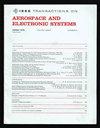Range Ambiguity Mitigation and Range-Angle Estimation With EPC-FDA-MIMO Radar
IF 5.7
2区 计算机科学
Q1 ENGINEERING, AEROSPACE
IEEE Transactions on Aerospace and Electronic Systems
Pub Date : 2025-01-07
DOI:10.1109/TAES.2025.3526908
引用次数: 0
Abstract
Range ambiguity is common for estimating range with the multiple-input–multiple-out (MIMO) radar employing elevated pulse repetition frequency (PRF). Despite that the frequency diverse array (FDA) or element-pulse coding (EPC) in transmitter provides possibility for resolving range ambiguity at a single PRF, the involved orthogonal waveform sequences are unpractical in pulse-Doppler radars. In this article, the MIMO-based hybrid of FDA and EPC is investigated to mitigate range ambiguity and enhance range resolution, which is so called EPC-FDA-MIMO. Employing the ampliative frequency offset in transmit antennas is to guarantee the orthogonality in frequency domain. The EPC scheme is employing the Fourier basis on the element-pulse dimension in transmitter. The associated receive processing approach is designed, which is characterized by the subband synthesis in frequency domain and the three-stage range-angle estimator. The subband synthesis is devised to enhance range resolution by utilizing the synthesized bandwidth. A three-stage estimator involves estimating angle in receive domain, estimating range region number and range quantization error in transmit domain. Further, the Cramér–Rao bounds for EPC-FDA-MIMO system are also conducted to examine the estimation performance of the range-angle estimator. Numerous simulation results are provided to verify the effectiveness of the proposed method.EPC-FDA-MIMO雷达的距离模糊消除和距离角估计
距离模糊是多输入多输出(MIMO)雷达采用高脉冲重复频率(PRF)估计距离时常见的问题。尽管发射机中的变频阵列(FDA)或单元脉冲编码(EPC)提供了在单个PRF下解决距离模糊的可能性,但所涉及的正交波形序列在脉冲多普勒雷达中是不实用的。本文研究了基于mimo的FDA和EPC的混合mimo,以减轻距离模糊和提高距离分辨率,即EPC-FDA- mimo。在发射天线中采用放大频偏是为了保证其频域正交性。EPC方案是在发射机的元脉冲维数上采用傅里叶基。设计了以频域子带合成和三级距离角估计器为特征的关联接收处理方法。设计子带合成是为了利用合成带宽来提高距离分辨率。三级估计包括接收域角度估计、发射域距离区域数估计和距离量化误差估计。此外,还对EPC-FDA-MIMO系统的cram - rao界进行了分析,以检验距离角估计器的估计性能。大量的仿真结果验证了所提方法的有效性。
本文章由计算机程序翻译,如有差异,请以英文原文为准。
求助全文
约1分钟内获得全文
求助全文
来源期刊
CiteScore
7.80
自引率
13.60%
发文量
433
审稿时长
8.7 months
期刊介绍:
IEEE Transactions on Aerospace and Electronic Systems focuses on the organization, design, development, integration, and operation of complex systems for space, air, ocean, or ground environment. These systems include, but are not limited to, navigation, avionics, spacecraft, aerospace power, radar, sonar, telemetry, defense, transportation, automated testing, and command and control.

 求助内容:
求助内容: 应助结果提醒方式:
应助结果提醒方式:


